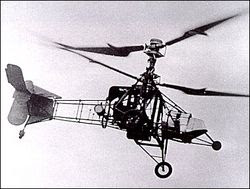The aircraft consisted of an open steel tube framework, within which the engine, fuel tank, controls and pilot were situated, together with a tail assembly with plywood tail surfaces. The tail wheel landing gear was installed with the main wheels on outriggers and with an additional small wheel at the front to avoid nosing-over during landing.
Power was provided by a 240 HP Hispano radial engine which propelled the two contra-rotating, coaxial rotors. The coaxial rotor design was chosen because with the rotors turning in opposite directions the torque from one rotor was canceled out by the torque produced by the other rotor.
The two, twin-bladed rotors made of metal were shaped like arrows and incorporated both cyclic and collective pitch blade control, with which movement around the pitch and roll axis was controlled, as well as climb and descent. (see swash plate). Gyroplane-Laboratoire, 1933
Gyroplane-Laboratoire, 1933
The Gyroplane Laboratoire is considered by some to be the first, practicable helicopter in the world. The frenchman, Louis Breguet, had already experimented with rotorcraft in 1909, however, he chose to concentrate on airplanes until the end of the 1920s. In 1929 he announced a set of patents which addressed the flight stabilization of rotorcraft. In 1931, Breguet created the Syndicat d'Etudes de Gyroplane (French for "Syndicate for Gyroplane Studies"), together with Rene Dorand as technical director. Their goal was the development of an experimental helicopter, which was called "Gyroplane Laboratoire".
The Bréguet Dorand aircraft was finished in 1933, after ground tests and an accident. The first flight took place on 26 June 1935. Within a short time the pilot, Maurice Claisse, was setting records with the aircraft:
The amount of attention received by the German Fw 61 from experts and the public, even though it came several years later, has detracted from the historical prestige of the Gyroplane Laboratoire, which, until the outbreak of World War II continued to fly and conduct further experiments. The only prototype was destroyed in 1943 during an allied air attack on the airport Villacoublay.
Source: Wikipedia
July 21, 2007
Gyroplane Laboratoire helicopter
Labels: Aircraft List
Subscribe to:
Post Comments (Atom)






No comments:
Post a Comment